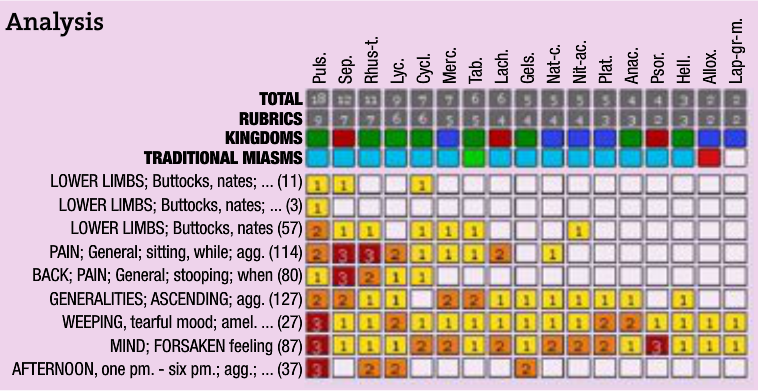“Wholism” Alleviates Pain: Pulsatilla and Weeping Reduce Pain in a 60-Year-Old Woman
Joseph Kellerstein, DC, ND
Elise is 60 years old. As she sits in the chair opposite me, I get the sense that she is tensed and anxious. At our first visit, this lady has carefully put down a buttock support in the chair and is struggling to find just the right angle for sitting in it.
According to the intake form, she reports chronic muscle pain and anxiety. She is currently taking lorazepam and duloxetine hydrochloride. She has a history of recent hip fracture and repair. Her first menses were at age 15 years.
Her chief complaint is pain radiating from just under her “sit bones.” It is worse when sitting and can extend to the low back. This began in the summer of 2010. The pain is also worse when going up and down stairs. It also gets worse from stooping.
As an interesting aside, Elise mentions that tears afforded some good relief when she allowed herself to cry. However, since her depression diagnosis and subsequent medication use, the tears have dried up, so this is no longer an outlet.
Soreness in both shoulder joints extends into the pectoral area just under the clavicles and then to the upper arms. These pains are of more recent onset, since the hip fracture when she had to “hoist herself around.”
By 4:30 pm every day, the pain becomes intense, and Elise must lie down. By then, her tears do flow, necessitating lorazepam.
The lower back hurts from stooping, and the shoulders hurt from lifting. Elise said: “I live with the pain all day. It becomes overwhelming. When I go into the kitchen and think about preparing a meal, it just takes over.”
The next complaint is hot flushes: “If I get a hot flush, I get an electric charge as if an electric current were running through my body.” It starts at the feet and ascends.
Further questioning yielded a history of emotional distress related to her work environment. Elise felt socially isolated there, where conflict existed with a fellow employee. Just knowing there was conflict in the room, and the proximity, was too much for her. She was soon ready for a change and left. Elise’s anxiety takes its origin here.

A radiologic report of the cervical spine noted a disc osseous bulge at C4-5. It was causing a mild central stenosis and foraminal narrowing.
The most striking and peculiar symptom in the case is clearly the amelioration of pain by weeping. The rest of the case demonstrates extensive support for Pulsatilla as a remedy. I was concerned about the patient’s emotional state. Pulsatilla 6 was prescribed every third day.
I just finished the first follow-up visit (so any improvement can only be classified as presumptive). Elise reports that her walking and sitting are much improved. The tightness in her hips has lessened.
Elise had gone for a walk in the forest this past weekend. She dared not even attempt this before. Six months ago, she had tried; just at the outset of that venture, she needed to turn back because of a sensation of coldness in the hips and tight soreness in the upper thighs, which reduced mobility. These sensations were much improved now. (Pulsatilla is not noted for coldness in the hip joints; if we continue to get reliable improvement in that symptom, I need to consider adding it to the repertory.)
I questioned Elise about the absence of her buttock support at this visit. She said she has not needed it since shortly after last being here, even for the hard seats in her vehicle.
She stated: “Yesterday, I noticed for the first time that if I remain busy around that 4:30 time and if I do not need to prepare a meal, I feel that there is no need for the usual lorazepam.” (Is this an improvement due to Pulsatilla in her mood that is indeed worse at this time of day, or is it an insight from observation and experimentation in life? Either way, it is an improvement.)
The hot flushes are less and do not have that electrical charge. She sat for a moment after reflecting and then exclaimed: “Yesterday, I did not need to be around people to feel OK. I always need to be around people—that is very different.”
To me, it seems I have some reason to feel happy with the prescription, even at this early 2-week mark. What has happened in this process?
I have relied on a law of nature—similia similibus curantur. Relevant are the observations by Hahnemann about his instructions in aphorism 153 of the Organon, where he tells us to pay attention especially to the most characteristic and peculiar elements in a case.
I have relied on the reproducibility of proving and repeated clinical observations established by Hahnemann and Hering in guiding symptoms. This is reflected in my explanations about Elise’s case and in the repertory chart.
Science is all about observational and experimental reproducibility vs vulnerability to falsification. Careful homeopathic prescription, with precise adherence to the methods of the Organon is as scientific as it gets.
We have a crisis in modern naturopathy—an identity crisis. There are some who really want to be MDs. Some NDs advertise themselves as “evidence based.” Their god is the “protocol.”
If what we want is to centralize our practice in “green allopathy,” we will deservedly disappear as a profession. Where is “wholism” and individualized treatment, and where is the responsibility of our schools to this creed?
 Joseph Kellerstein, DC, ND graduated as a chiropractor in 1980 and as an ND in 1984. He graduated with a specialty in homeopathy from the Canadian Academy for Homeopathy, and subsequently lectured there for 2 years. He also lectured in homeopathy for several years at CCNM; for 8 years at the Toronto School of Homeopathic Medicine; and for 2 years at the British Institute for Homeopathy. Dr Kellerstein’s mission is the exploration of natural medicine in a holistic context, especially homeopathy and facilitating the experience of healing in clients.
Joseph Kellerstein, DC, ND graduated as a chiropractor in 1980 and as an ND in 1984. He graduated with a specialty in homeopathy from the Canadian Academy for Homeopathy, and subsequently lectured there for 2 years. He also lectured in homeopathy for several years at CCNM; for 8 years at the Toronto School of Homeopathic Medicine; and for 2 years at the British Institute for Homeopathy. Dr Kellerstein’s mission is the exploration of natural medicine in a holistic context, especially homeopathy and facilitating the experience of healing in clients.










